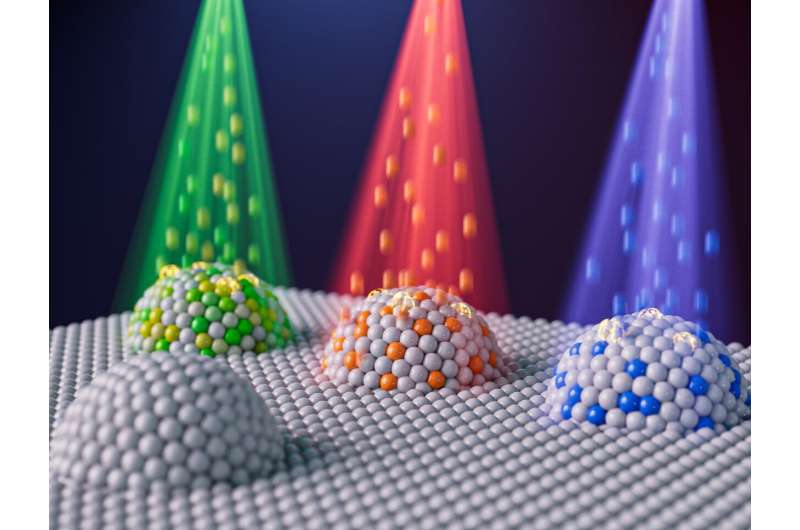This article has been reviewed according to Science X's editorial process and policies. Editors have highlighted the following attributes while ensuring the content's credibility:
fact-checked
peer-reviewed publication
trusted source
proofread
Researchers engineer nanoparticles using ion irradiation to advance clean energy, fuel conversion

MIT researchers and colleagues have demonstrated a way to precisely control the size, composition, and other properties of nanoparticles key to the reactions involved in a variety of clean energy and environmental technologies. They did so by leveraging ion irradiation, a technique in which beams of charged particles bombard a material.
They went on to show that nanoparticles created this way have superior performance over their conventionally made counterparts.
"The materials we have worked on could advance several technologies, from fuel cells to generate CO2-free electricity to the production of clean hydrogen feedstocks for the chemical industry [through electrolysis cells]," says Bilge Yildiz, leader of the work and a professor in MIT's Department of Nuclear Science and Engineering and Department of Materials Science and Engineering.
Critical catalyst
Fuel and electrolysis cells both involve electrochemical reactions through three principal parts: two electrodes (a cathode and anode) separated by an electrolyte. The difference between the two cells is that the reactions involved run in reverse.
The electrodes are coated with catalysts, or materials that make the reactions involved go faster. But a critical catalyst made of metal-oxide materials has been limited by challenges including low durability. "The metal catalyst particles coarsen at high temperatures, and you lose surface area and activity as a result," says Yildiz, who is also affiliated with the Materials Research Laboratory and is an author of a paper on the work published in the journal Energy & Environmental Science.
Enter metal exsolution, which involves precipitating metal nanoparticles out of a host oxide onto the surface of the electrode. The particles embed themselves into the electrode, "and that anchoring makes them more stable," says Yildiz. As a result, exsolution has "led to remarkable progress in clean energy conversion and energy-efficient computing devices," the researchers write in their paper.
However, controlling the precise properties of the resulting nanoparticles has been difficult. "We know that exsolution can give us stable and active nanoparticles, but the challenging part is really to control it. The novelty of this work is that we've found a tool—ion irradiation—that can give us that control," says Jiayue Wang, first author of the paper. Wang, who conducted the work while earning his MIT Ph.D. in the Department of Nuclear Science and Engineering, is now a postdoctoral scholar at Stanford.
Sossina Haile is the Walter P. Murphy Professor of Materials Science and Engineering at Northwestern University. Says Haile, who was not involved in the current work, "Metallic nanoparticles serve as catalysts in a whole host of reactions, including the important reaction of splitting water to generate hydrogen for energy storage. In this work, Yildiz and colleagues have created an ingenious method for controlling the way that nanoparticles form."
Haile continues, "the community has shown that exsolution results in structurally stable nanoparticles, but the process is not easy to control, so one doesn't necessarily get the optimal number and size of particles. Using ion irradiation, this group was able to precisely control the features of the nanoparticles, resulting in excellent catalytic activity for water splitting."
What they did
The researchers found that aiming a beam of ions at the electrode while simultaneously exsolving metal nanoparticles onto the electrode's surface allowed them to control several properties of the resulting nanoparticles.
"Through ion-matter interactions, we have successfully engineered the size, composition, density, and location of the exsolved nanoparticles," the team writes in Energy & Environmental Science.
For example, they could make the particles much smaller—down to two billionths of a meter in diameter—than those made using conventional thermal exsolution methods alone. Further, they were able to change the composition of the nanoparticles by irradiating with specific elements. They demonstrated this with a beam of nickel ions that implanted nickel into the exsolved metal nanoparticle. As a result, they demonstrated a direct and convenient way to engineer the composition of exsolved nanoparticles.
"We want to have multi-element nanoparticles, or alloys, because they usually have higher catalytic activity," Yildiz says. "With our approach the exsolution target does not have to be dependent on the substrate oxide itself." Irradiation opens the door to many more compositions. "We can pretty much choose any oxide and any ion that we can irradiate with and exsolve that," says Yildiz.
The team also found that ion irradiation forms defects in the electrode itself. And these defects provide additional nucleation sites, or places for the exsolved nanoparticles to grow from, increasing the density of the resulting nanoparticles.
Irradiation could also allow extreme spatial control over the nanoparticles. "Because you can focus the ion beam, you can imagine that you could 'write' with it to form specific nanostructures," says Wang. "We did a preliminary demonstration [of that], but we believe it has potential to realize well-controlled micro- and nano-structures."
The team also showed that the nanoparticles they created with ion irradiation had superior catalytic activity over those created by conventional thermal exsolution alone.
More information: Jiayue Wang et al, Ion irradiation to control size, composition and dispersion of metal nanoparticle exsolution, Energy & Environmental Science (2023). DOI: 10.1039/D3EE02448B
Journal information: Energy & Environmental Science



















